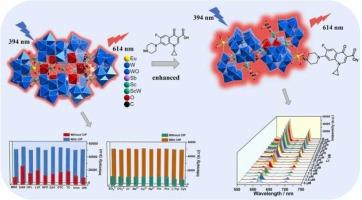Neoteric EuIII-ScIII共掺入抗单钨酸盐用于环丙沙星的荧光检测
IF 3.7
1区 化学
Q1 CHEMISTRY, ANALYTICAL
引用次数: 0
摘要
牲畜养殖中滥用环丙沙星(CIP)已导致其在食物链和环境系统中持续积累,对人类健康和生态稳定构成重大风险。因此,开发一种高灵敏度和特异性的CIP检测方法对于确保食品安全和保持质量控制标准至关重要。然而,目前的检测技术仍然容易受到CIP家族结构类似物的干扰。为了解决这一挑战并提高CIP检测的特异性,开发了一种创新的荧光传感器。该传感器基于新型EuIII-ScIII共掺杂反单钨酸盐杂化物[H2N(CH3)2]13Na14H5{[[W0.33Sc0.67]2{[[W0.33Sc0.67]2(Htar)O4]2W6Sc7Eu(H2O)5O16(H2O)8[B-β-SbW9O33]6}·77H2O(1),通过多组分配位组装法合成。结构分析表明,除1多氧阴离子内的[B-β-SbW9O33]9 -片段外,17个金属离子通过20 μ 2- o原子相互连接,形成独特的17核双金属[[W0.33Sc0.67]2(Htar)O4]2W6Sc7O16(H2O)8]19+簇。重要的是,位于多氧阴离子两侧的[Eu(H2O)6]3+离子将相邻的多氧阴离子连接成一维链状结构。利用1作为荧光探针,激发后在614 nm处有很强的荧光发射。CIP的引入通过“天线效应”显著增强了614 nm处的荧光强度,实现了高灵敏度的检测。该特性使传感器具有优异的分析性能,实现低检测限。该传感平台在人血清和食品样品中CIP检测具有较高的实用性,在食品中抗生素残留监测和药物筛选方面具有较大的应用潜力本文章由计算机程序翻译,如有差异,请以英文原文为准。

Neoteric EuIII–ScIII co-incorporated antimonotungstate utilized for fluorescence detection of ciprofloxacin
The indiscriminate use of ciprofloxacin (CIP) in livestock farming has led to its persistent accumulation in food chains and environmental systems, posing significant risks to human health and ecological stability. Therefore, developing a highly sensitive and specific method for detecting CIP has become essential to ensure food safety and maintain quality control standards. However, current detection techniques remain susceptible to interference from structural analogues within the CIP family. To address this challenge and improve the specificity of CIP detection, an innovative fluorescent sensor was developed. This sensor is based on a novel EuIII–ScIII co-incorporated antimonotungstate hybrid [H2N(CH3)2]13Na14H5{[[W0.33Sc0.67]2{[[W0.33Sc0.67]2(Htar)O4]2W6Sc7Eu(H2O)5O16(H2O)8[B-β-SbW9O33]6}·77H2O (1) synthesized via a multicomponent coordination assembly approach. Structural analysis reveals that, excluding the [B-β-SbW9O33]9− fragments within the polyoxoanion of 1, seventeen metal ions are interconnected through twenty µ2-O atoms, forming a unique seventeen-nuclear bimetallic [[W0.33Sc0.67]2(Htar)O4]2W6Sc7O16(H2O)8]19+ cluster. Importantly, the [Eu(H2O)6]3+ ions located on both sides of the polyoxoanion connect adjacent polyoxoanions into a one-dimensional chain-like architecture. Moreover, 1 was utilized as a fluorescent probe, exhibiting strong fluorescence emission at 614 nm upon excitation. The introduction of CIP significantly enhances the fluorescence intensity at 614 nm through the “antenna effect”, enabling highly sensitive detection. This property provides the sensor with excellent analytical performance, achieving low detection limits. This sensing platform demonstrates high practical applicability in detecting CIP in human serum and food samples, highlighting its potential for antibiotic residue monitoring in food products and pharmaceutical screening.
求助全文
通过发布文献求助,成功后即可免费获取论文全文。
去求助
来源期刊

Sensors and Actuators B: Chemical
工程技术-电化学
CiteScore
14.60
自引率
11.90%
发文量
1776
审稿时长
3.2 months
期刊介绍:
Sensors & Actuators, B: Chemical is an international journal focused on the research and development of chemical transducers. It covers chemical sensors and biosensors, chemical actuators, and analytical microsystems. The journal is interdisciplinary, aiming to publish original works showcasing substantial advancements beyond the current state of the art in these fields, with practical applicability to solving meaningful analytical problems. Review articles are accepted by invitation from an Editor of the journal.
 求助内容:
求助内容: 应助结果提醒方式:
应助结果提醒方式:


